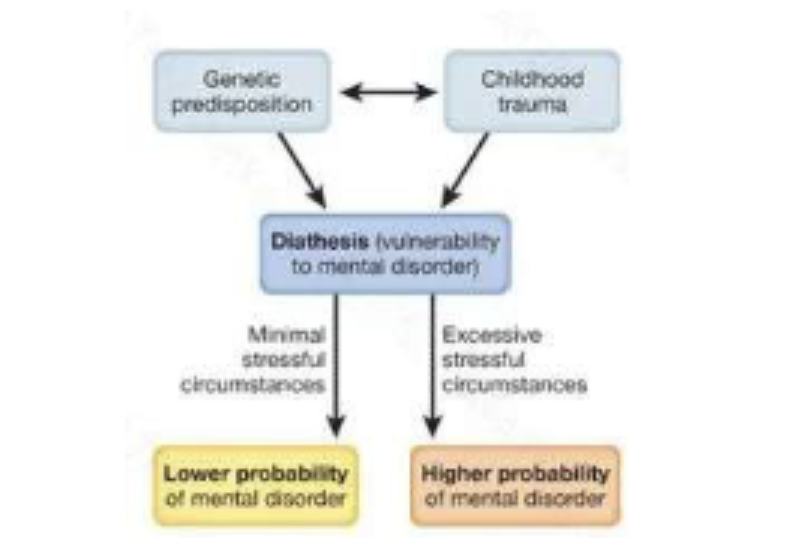psych personality disorders
1/22
There's no tags or description
Looks like no tags are added yet.
Name | Mastery | Learn | Test | Matching | Spaced |
|---|
No study sessions yet.
23 Terms
how poeple think of severly mentally ill
examples from the news that have been discusssed as being extrememly mentally ill
generational divide and shift in language
ex: someone is strugglingw ith their mental health, mroe associated with normalized mental illnesses
a lot of young people have been through the pandemic and if you’re coming of age, one thing that happens during that time is significant anxiety and depression bc of the stressful experiences, a lot going on and things uncertain
we’re still seeing higher rates of a nxiety and depression befoere covide ven though we’ve decreased a bit'/got down from the peak.
mental disorders are smth that we have an attitude towards
explain the interaction study
there’s this interaction study that asks if you’ve been hospitalized or nont either no, yes panic disorder, yes depression, yes schizophrenia
behavior measure of your willingness to interact with someone that has or has not been in the hospital
they found in control condition, 9o percent of hte indivs are willing to interact with someone that has been hospitalized with panic disoder /control
drop with someoen that has been hospitalized for depression, drop again for those who have been hospitalized for schizophrenia, less than 5o percent
the more they believe that those with mental illnesses have a negative reaction with those with mental disorders, the less likely they will report that they need help
what is psychopathology
a disorder of the mind
the overrachring category
why does cultural context shape the way we consider what is abdnormal
psychological disorders exist globally but there is some cultural bariation
ex: taijin kyofusho-japan mental disorder: people are afriad to interact with others bc they feel like parts of their body don’t smell good
there are similarities between mental disorders but it can be specific on the culture
it has to be abnormal and our cultural norms set the ocntext for us of what is considered normal vs deviant
about how many americans will suffer from a psychological disorder at some point in their lives
how many will be severely effected
about half of americans will suffer from a psychological disorder at some point in their lives
however only 7 percent iwll be severly effected
what is abnormal vs atypical
a lot of ppl in our society are atypical, aren’t normal like beyonce, steve jobs, etc
just bc you’re atypical does not mean you have a psychological disorder
what are the 3 criteria for abnormal,
deviant” behavior that violates the norms of what’s expected, one of the ways that cultural context matters bc what is deviant here might not be deviant somewhere else, have ot think of where you are before consideering if it’s deviant
maladaptive/dysfunctional : interferes with functioning, danger to yourself or danger to others, losing touch between reality and your experiences
personal distress: behavior must lead to personal distress, pretty standard
what are the three deviants
deviant, dysfunctional, and distressing
if you meet all 3 it’s abnormal, but you don’t always have to meet all 3
emphasize maladaptive the most, just being deviant is not enough to be concerned abt it you have to have dysfuncitonal and distress
beehaviors vary from being functional to dysfunctional, it’s like a sliding scale
behavior can be functional vs dysfunctional depending on social context
what is the diagnostic criteria
DSM5TR
gives us a set of criteria that a person is required to meet to be diagnosed with a specific disorder
we do a standardized assesment
there are also guidelines to assessments
you can observe behavior on certain tasks
labeling numbers on clock is good for labeling dimensia, must be done by a professional
DSM sorts disorders to categories
the distinguisihing features result in diff diagnostic labels
people can have more than 1 diagnosis, v common
when ppl ahve 2 or more diagnoses, we call that comorbidity=multiple disorders at the same time
standard evlauation criteria
common basis for communication - ties sets of symptoms to disorder labels, labels can be useful to allow scientists in diff places to have a common term
enables research and treatment
soem disorders that go together
depression and anxiety occur together-comorbid
diagnostic and statistic anual of disorders -text reviison, not enough to make a new edition
what are the cons of the DSM
entirely categorical, you have this disorder or you don’t
human behavior exists on a spectrum and it doesn’t deal with that spectrum
focuses on problems-not sections are psychological strengths, very disorder focus
labels open risk of stigma, gives us assessmnent tasks and criteria to label their experiences, smth small as a label can impact our willingness to interact iwth others and we could be continuingg this cycle of stigma
what is the biological approach
the root of psychological disorder is essentialy biological
gets us a medical model of mental disorders, we see them as physical illnesses that need to be treated via medication
doesn’t acount for everything realted to mental disorders
what is the psychlogical model
focuses on our internal psych epxeirences like emotions, trauma, our personality, our childhood experiences can inform our disorders,
ex like cognitive behavioral therapists
what is the sociocultural model
approaches psych disorders as a mitch match between int between a person and their behaviors and their ocntexts
perfered model/ biopsychosocial model
the best model is all of them smooshed together
bio+ psych+sociocultural model
all models interact together
consider influences of all these diff groups
what is the vulnerability stress model, also called the diathysis stress model
childhood trauma can influence genetic pedisposition OR vice versa
biological factors interacting with personal experiences
as we encounter stress, low levels of probability of developing a mental disorder
high levels of probability increase the probability of developing a mental disorder
